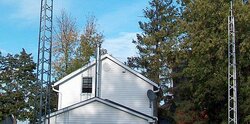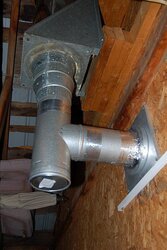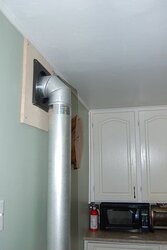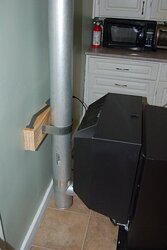Hey folks, I'm new here but I'm the proud new owner of a Harman P43 pellet stove. My propane furnace gave up, so rather than pay a fortune (and a huge mess of my house, long story) to have it replaced right now, I decided to get this. It will be the main heat source in my small 900 sq foot home in Eastern Ontario.
The stove works awesome, it fires a ton of heat. I'm actually looking forward to some colder weather to see how it does.
One problem so far. When it first fires up, or when it's running really low and then I crank it up, I can smell smoke for a bit. There doesn't appear to be any smoke in the room, just an odor. Smells just like someone left a board in one place too long while making a cut with a table saw or something. Is this smell normal? I don't mind the smell at all, I just want to be sure I'm not going to be slowly poisoned with CO or something.
I should add that it was a self install, but it was done well. All joints are caulked with high temp silicone, and taped. The 4" vent pipe goes from a T on the back of the stove, up 5ft to a 90, horizontal for 18" to another T at the base of an existing chimney, then there's 15ft of vertical to go about 3ft above the roof. It draws extremely well, before sliding the stove in place I could feel a bit of a vacuum on the end of the pipe (maybe this isn't a good thing for efficiency? I dunno, but the house is 100 years old. It's reasonably sealed, but there's bound to be some leaks). My profile pic shows the install. I am not using an outside air kit, but I'm not opposed to installing one.
So, is the smoke smell when starting or being cranked up a normal thing, or no?
The stove works awesome, it fires a ton of heat. I'm actually looking forward to some colder weather to see how it does.
One problem so far. When it first fires up, or when it's running really low and then I crank it up, I can smell smoke for a bit. There doesn't appear to be any smoke in the room, just an odor. Smells just like someone left a board in one place too long while making a cut with a table saw or something. Is this smell normal? I don't mind the smell at all, I just want to be sure I'm not going to be slowly poisoned with CO or something.
I should add that it was a self install, but it was done well. All joints are caulked with high temp silicone, and taped. The 4" vent pipe goes from a T on the back of the stove, up 5ft to a 90, horizontal for 18" to another T at the base of an existing chimney, then there's 15ft of vertical to go about 3ft above the roof. It draws extremely well, before sliding the stove in place I could feel a bit of a vacuum on the end of the pipe (maybe this isn't a good thing for efficiency? I dunno, but the house is 100 years old. It's reasonably sealed, but there's bound to be some leaks). My profile pic shows the install. I am not using an outside air kit, but I'm not opposed to installing one.
So, is the smoke smell when starting or being cranked up a normal thing, or no?





